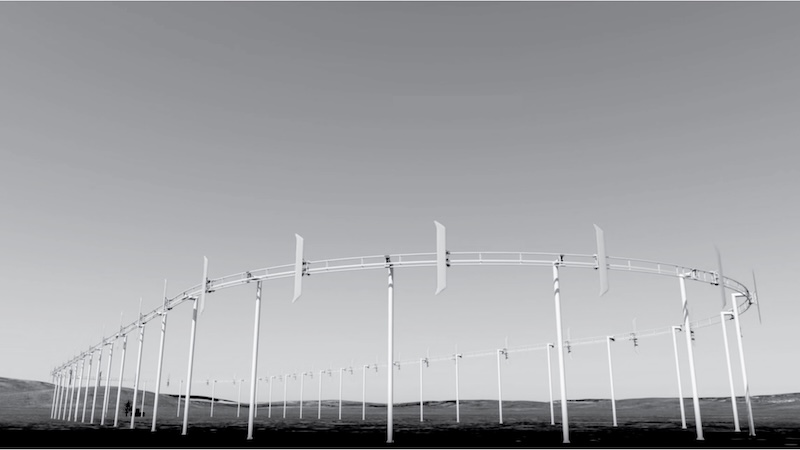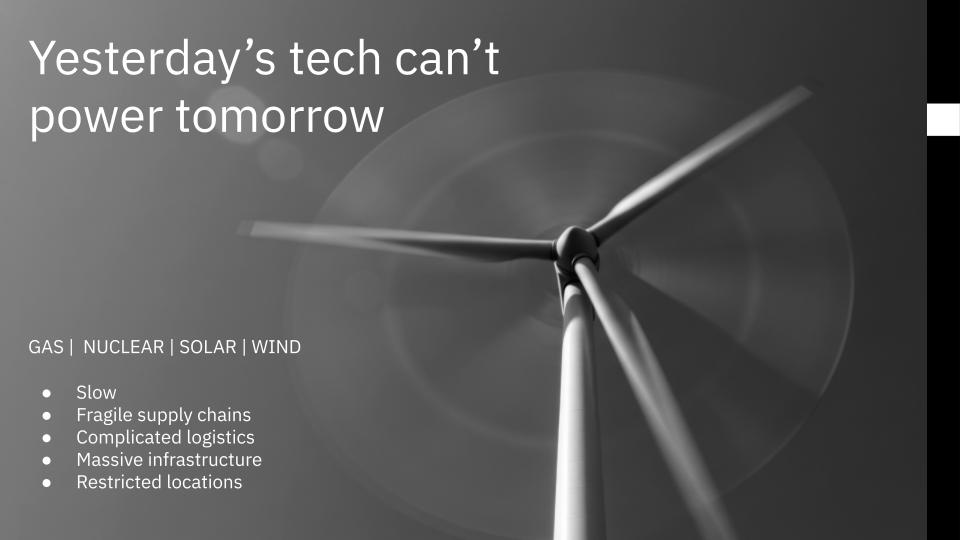Reinventing Wind: From Heavy Industry to Model T
Many of us have been in the energy game long enough to watch solar transform from niche technology to the fastest-deploying energy source on the planet. And I keep thinking: Wind has been missing its moment.
We’re sitting on the cusp of unprecedented energy demand, which could double, or even triple between 2023 and 2050. Data centers alone could jump from 4 percent to potentially 12 percent of all electricity consumption as soon as 2030-2035. Gas projects are crawling along at their usual glacial pace, taking 5-10 years to come online. Nuclear is 10-15 years away. Other renewables, while necessary, are still figuring out scale and efficiency. There's a massive gap forming between energy supply and demand. Wind, with the right reinvention, could be sprinting to fill it.
Instead, we're still thinking like it's 1995.

The problem with going big
Traditional horizontal-axis wind turbines (HAWTs) have delivered impressive gains — with capacity factors improving from 22 to 35 percent historically. But they’ve been running the same plays for decades: more capacity per unit, bigger blades, and taller towers often soaring higher than the Golden Gate Bridge.
Locking wind into the “bigger is better” paradigm keeps us on a path of diminishing returns as new challenges arise. Think about it: supply chain vulnerabilities are driven by dependence on specialized materials, or low-volume manufacturing, or complex transportation, along with installation infrastructure requirements. Meanwhile, location constraints persist as HAWTs remain limited to an ever-narrower set of suitable wind sites, creating geographic bottlenecks exactly when we need maximum — and speedy — deployment flexibility. And as project developers tell us they need power online in 12-18 months, current HAWT timelines of 5-6 years aren’t going to cut it.
The economics don't work anymore.
Can we take a page out of the solar playbook? Can wind go from heavy industrial to mass manufacturing and low-cost production that can be delivered in months, not years?
Lessons from our friends in solar
Solar has largely figured out the agility equation through modular designs, standardized components, and faster deployment cycles.
With smaller installations that are easier to permit, they avoid flight and/or military conflicts, require smaller setbacks, encounter less community resistance than traditional HAWT farms, and reach remote locations more readily. The massive size and weight of traditional wind turbines also require specialized equipment and infrastructure to move oversized blades, towers, and nacelles. All of this complexity drives up costs and can cause delays. In contrast, solar components are smaller, lighter, and modular, allowing for easier, faster, and more cost-effective transportation and on-site assembly. Solar systems are delivered using standard trucks and installed without heavy-lift equipment, making logistics simpler and more flexible.

What if wind energy used easy-to-source materials and standardized components across power outputs? Can wind energy develop automated production lines with repeatable assembly processes? What if wind turbines used the same materials and parts whether they were 100 kilowatts or 3 megawatts?
The demand gap, and the capital opportunity
Federal support for wind and solar is all but disappearing over the next 24 months. How will traditional wind and next-generation wind startups respond?
For technologies that design differently, and can stand on their own economic merits, we’re seeing private capital begin to fill the funding gaps. Right now, that capital is particularly interested in solutions that can serve the exploding demand from tech companies and data infrastructure. Companies like Microsoft, Google, and Amazon are signing power purchase agreements for gigawatts of capacity, but they need it fast. Big Tech isn't waiting for policy certainty. They're making multi-billion-dollar commitments to clean energy because they need predictable, long-term power costs and carbon-neutral operations. They're also willing to pay a premium for speed — something traditional wind hasn't prioritized.
Wind has a chance to reinvent itself in a way that can help close the demand gap, allowing for deployment on the same timeline as solar, with similar cost predictability and installation speed.

Time to move
Companies that stop thinking like heavy industry and start thinking like a technology company will shape a new look for wind energy.
Instead of chasing ever-larger turbines, let’s pursue a new wind paradigm anchored in modular designs that deploy quickly and economically. Higher energy density per site, lower transportation costs, faster installation cycles, and reduced maintenance complexity. Upfront investment is needed for new technologies, but factoring in speed to market, geographic flexibility, operational efficiency, and maintenance savings, we can install wind projects in months instead of years.
Power infrastructure needs the same flexibility we first saw with solar. Wind tech with better agility, greater modularity, and faster deployment will own the next decade of energy growth.
The grid is waiting. The customers are ready. The capital is out there. Time to stop building monuments and start building solutions.
Neal Rickner is the CEO of Airloom Energy. Based in Laramie, Wyoming, Airloom develops low-cost, utility-scale, resilient energy generation technology that is simple to manufacture, transport, and can be installed anywhere. Before Airloom, Neal served as the CEO of BridgeTek Energy and the Managing Partner of Elevation Ventures and spent nearly a decade at Google and Google[x] leading teams and developing energy projects. Prior to working in tech, Neal served 12 years on active duty in the U.S. Marine Corps as an F/A-18 pilot and forward air controller. He completed three tours in Iraq between 2003 and 2007, earning the Bronze Star and 13 Air Medals. He transitioned from active duty in 2009, earning dual master’s degrees from Columbia University. He is a co-host for the Hardpoints Podcast, and currently lives with his family in Dana Point, California. Connect with Neal and the Airloom team at [email protected].
Airloom Energy | www.airloom.energy
Author: Neal Rickner
Volume: 2025 September/October








